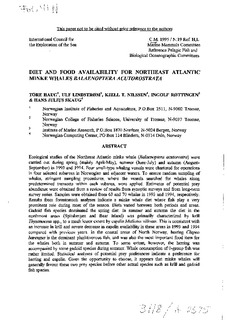| dc.contributor.author | Haug, Tore | |
| dc.contributor.author | Lindstrøm, Ulf | |
| dc.contributor.author | Nilssen, Kjell Tormod | |
| dc.contributor.author | Røttingen, Ingolf | |
| dc.contributor.author | Skaug, Hans Julius | |
| dc.date.accessioned | 2012-09-21T05:49:42Z | |
| dc.date.available | 2012-09-21T05:49:42Z | |
| dc.date.issued | 1995 | |
| dc.identifier.citation | This report is not to be cited without prior reference to the authors | no_NO |
| dc.identifier.uri | http://hdl.handle.net/11250/105481 | |
| dc.description.abstract | Ecological studies of the Northeast Atlantic minke whale (Balaenoptera acutorostra) were
carried out during spring (mainly April-May), summer (June-July) and autumn (AugustSeptember)
in 1993 and 1994. Four small-type whaling vessels were chartered for operations
in four selected subareas in Norwegian and adjacent waters. To ensure random sampling of
whales, stringent sampling procedures, where the vessels searched for whales along
predetermined transects within each subarea, were applied. Estimates of potential prey
abundance were obtained from a review of results from synoptic surveys and from long-term
survey series. Samples were obtained from 63 and 70 whales in 1993 and 1994, respectively.
Results from forestomach analyses indicate a minke whale diet where fish play a very
prominent role during most of the season. Diets varied between both periods and areas.
Gadoid fish species dominated the spring diet. In summer and autumn the diet in the
northmost areas (Spitsbergen and Bear Island) was primarily characterized by krill
Thysanoessa spp., to a much lesser extent by capelin Mallotus villosus. This is consistent with
an increase in krill and severe decrease in capelin availability in these areas in 1993 and 1994
compared with previous years. In the coastal areas of North Norway, herring Clupea
harengus is the dominant planktivorous fish, and was also the most important food item for
the whales both in summer and autumn. To some extent, however, the herring was
accompanied by some gadoid species during summer. Whale consumption of 0-group fish was
rather limited. Statistical analyses of potential prey preferences indicate a preference for
herring and capelin. Given the opportunity to choose, it appears that minke whales will
generally favour these two prey species before other actual species such as krill and gadoid
fish species. | no_NO |
| dc.language.iso | eng | no_NO |
| dc.publisher | ICES | no_NO |
| dc.relation.ispartofseries | ICES CM Documents;1995/N:19 | |
| dc.subject | minke whale | no_NO |
| dc.subject | vågehval | no_NO |
| dc.subject | food supply | no_NO |
| dc.subject | mattilgang | no_NO |
| dc.subject | sampling | no_NO |
| dc.subject | prøvetaking | no_NO |
| dc.subject | stomach data | no_NO |
| dc.subject | magedata | no_NO |
| dc.title | Diet and food availability for Northeast Atlantic minke whales Balaenoptera acutorostrata | no_NO |
| dc.type | Working paper | no_NO |
| dc.subject.nsi | VDP::Agriculture and fishery disciplines: 900::Fisheries science: 920::Resource biology: 921 | no_NO |
| dc.subject.nsi | VDP::Agriculture and fishery disciplines: 900::Fisheries science: 920::Fish health: 923 | no_NO |
| dc.source.pagenumber | 34 s. | no_NO |
